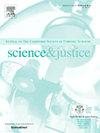Extended reality in forensic sciences: An integrative review
IF 2
4区 医学
Q2 MEDICINE, LEGAL
引用次数: 0
Abstract
The use of extended reality (XR), an umbrella term encompassing alternative reality technologies such as augmented reality, virtual reality, and mixed reality, has become increasingly prevalent in various fields of literature over the last few decades. However, there is a limited understanding of XR utilization and integration in forensic science. This integrative review synthesized existing evidence on how XR is being utilized in forensic science. We performed literature searches in four databases and identified 21 articles published between 2010 and 2023 for final analysis. Bibliometric information indicates that most publications (81 %) were published between 2019 and 2023, predominantly in European regions (67 %), in non-forensic journals. Methodologically, qualitative approaches (67 %) were common in evaluating XR usability. Its applications are clustered into either practice (57 %) or education (43 %) domains. Virtual reality (67 %) was more prevalent in XR environments than augmented or mixed realities. Head-mounted devices are the main XR system used in forensic science. While XR offers promising practical and educational applications in forensic science, these findings underscore the need for more robust evidence and the development of transparent, repeatable, and standardized protocols that align with decision-making and accountability in forensic science.
法医学中的扩展现实:综合综述
扩展现实(XR)是一个涵盖了增强现实、虚拟现实和混合现实等替代现实技术的总称,在过去几十年里,它在各个文学领域变得越来越普遍。然而,法医科学对XR的利用和整合的了解有限。这篇综合综述综合了关于如何在法医科学中利用x光成像的现有证据。我们在四个数据库中进行文献检索,并确定了2010年至2023年间发表的21篇文章进行最终分析。文献计量学信息表明,大多数出版物(81%)发表于2019年至2023年之间,主要发表在欧洲地区(67%)的非法医期刊上。在方法学上,定性方法(67%)在评估XR可用性中很常见。它的应用集中在实践(57%)或教育(43%)领域。虚拟现实(67%)在XR环境中比增强现实或混合现实更普遍。头戴式设备是法医科学中使用的主要XR系统。虽然XR在法医学中提供了有前景的实践和教育应用,但这些发现强调了需要更有力的证据,并需要制定透明、可重复和标准化的协议,以与法医学的决策和问责制保持一致。
本文章由计算机程序翻译,如有差异,请以英文原文为准。
求助全文
约1分钟内获得全文
求助全文
来源期刊

Science & Justice
医学-病理学
CiteScore
4.20
自引率
15.80%
发文量
98
审稿时长
81 days
期刊介绍:
Science & Justice provides a forum to promote communication and publication of original articles, reviews and correspondence on subjects that spark debates within the Forensic Science Community and the criminal justice sector. The journal provides a medium whereby all aspects of applying science to legal proceedings can be debated and progressed. Science & Justice is published six times a year, and will be of interest primarily to practising forensic scientists and their colleagues in related fields. It is chiefly concerned with the publication of formal scientific papers, in keeping with its international learned status, but will not accept any article describing experimentation on animals which does not meet strict ethical standards.
Promote communication and informed debate within the Forensic Science Community and the criminal justice sector.
To promote the publication of learned and original research findings from all areas of the forensic sciences and by so doing to advance the profession.
To promote the publication of case based material by way of case reviews.
To promote the publication of conference proceedings which are of interest to the forensic science community.
To provide a medium whereby all aspects of applying science to legal proceedings can be debated and progressed.
To appeal to all those with an interest in the forensic sciences.
 求助内容:
求助内容: 应助结果提醒方式:
应助结果提醒方式:


